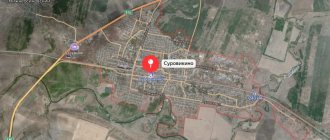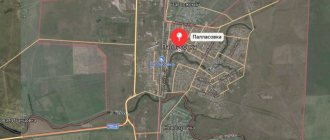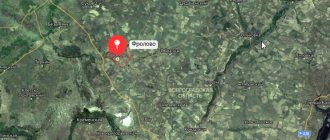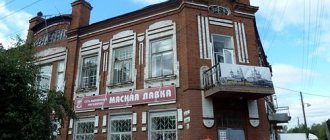Population
The first population census took place here in 1886 - the population then was about 3,000 people. In 1970, more than 37 thousand people lived in the Kotovsky district. Subsequently, the number of residents increased slightly, but at this stage it has decreased and is about 30.5 thousand residents.
Houses for maternal capital in the Volgograd region
The city's population is approximately 70% of the total. The region is represented by a large number of nationalities: Russians, Tatars, Cossacks, Ukrainians, Chechens, Kurds, Koreans, Chuvash, Germans, Armenians and others.
Map
| Kotovo: maps |
Kotovo: photo from space (Google Maps) Kotovo: photo from space (Microsoft Virtual Earth)
| Kotovo. Nearest cities. Distances in km. on the map (in brackets along roads) + direction. Using the hyperlink in the distance , you can get the route (information courtesy of the AutoTransInfo website) | |||
| 1 | Petrov Val | 35 (37) | SE |
| 2 | Krasny Yar | 42 (44) | WITH |
| 3 | Danilovka | 48 (68) | Z |
| 4 | Kamyshin | 49 (59) | SE |
| 5 | Olkhovka | 53 (75) | YU |
| 6 | Rudnya | 56 (106) | WITH |
| 7 | Nikolaevsk | 57 (73) | SE |
| 8 | Linevo | 63 (70) | WITH |
| 9 | Bykovo | 73 (102) | SE |
| 10 | Zhirnovsk | 74 (83) | WITH |
| 11 | Krasnoarmeysk | 100 (183) | NE |
| 12 | Rovnoe (Saratov region) | 101 (303) | NE |
| 13 | Frolovo | 102 (155) | SW |
| 14 | Yelan | 103 (161) | NW |
| 15 | Mikhailovka | 114 (145) | Z |
| 16 | Old Poltavka | 120 (249) | IN |
a brief description of
The city is located in the southern part of the Volga Upland, on the river. Kazanka (Don basin), 16 km west of the railway. Lapshinskaya station, 229 km north of Volgograd. Road junction.
Territory (sq. km): 72
Information about the city of Kotovo on the Russian Wikipedia site
Historical sketch
Founded in the 1710s. The name of the village Kotovo comes from the surname Kotov.
Workers' village since 1958. City since 12/20/1966.
Economy
Kotovo is the center of the oil-producing region.
Factories: experimental drilling equipment, gas processing, "Sulfur purification", "Impulse", brick, reinforced concrete products, butter factory.
In the Kotovsky district, rye, wheat, millet, barley, corn, and sunflower are grown. Vegetable growing, melon growing. Fine wool sheep breeding. They raise cattle (meat and dairy), pigs, and goats. Poultry farming.
Deposits of oil, gas, iron ore, limestone, clay.
Main enterprises
OIL PRODUCTION INDUSTRY
NGDU "Korobkovskoye" OJSC "Lukoil-Nizhnevolzhskneft"
403810, Volgograd region, Kotovsky district, Kotovo, st.
Neftyanikov, 1 Offers:
oil
Culture, science, education
Museum of History and Local Lore.
Architecture, sights
Church of the Archangel Michael (1791), Karpov's house (1860), the building of the former volost administration (1864).
20 km from Kotovo - Lapshinskaya water tower (1894), 45 km from Kotovo - Netkachevskaya tower (1894).
Mounds: “Red Kurgan” (8 km from Kotovo), “Mozhary” (9 km from Kotovo), “Omelkova Mogila” and “Red Wolf” (14 km from Kotovo), “Chekhan” (18 km from Kotovo).
| Population by year (thousands of inhabitants) | |||||||
| 1939 | 2.9 | 1996 | 28.0 | 2007 | 25.8 | 2015 | 22.9 |
| 1959 | 7.2 | 1998 | 28.4 | 2008 | 25.6 | 2016 | 22.7 |
| 1967 | 17 | 2000 | 28.6 | 2010 | 25.2 | 2017 | 22.5 |
| 1970 | 20.6 | 2001 | 28.4 | 2011 | 24.1 | 2018 | 22.0 |
| 1979 | 23.1 | 2003 | 26.8 | 2012 | 23.8 | 2019 | 21.8 |
| 1989 | 25.4 | 2005 | 26.3 | 2013 | 23.6 | 2020 | 21.4 |
| 1992 | 26.3 | 2006 | 26.0 | 2014 | 23.3 | 2021 | 21.1 |
Story
The history of the settlement dates back to 1710, when the first immigrants from the Kharkov and Poltava provinces settled here. Among them was a Little Russian who bore the surname Kotenko, which is where the name of the settlement came from. Then other small settlements began to form in the surrounding area, formed by state-owned Ukrainian peasants.
Over time, the city was developed; it was filled with residential buildings and industrial buildings. The Archangel Michael Church was built from stone. The five streets that made up the city at that time ran parallel to the river. Kazanka.
Each household had its own vegetable garden and orchard. The number of wells in the village exceeded a hundred. The surrounding area is surrounded by arable land and forests. In Kotovo there were three large gardens with fruit trees, on the territory of which there were springs and lakes. This area was rich in natural springs, bogs and swamps.
In 1842, the parish school began to operate, and the second, the zemstvo school, opened in 1894. By 1914, 4 more schools were added to this number, a fire department, a paramedic station, a postal station, 7 oil mills, a volost court, and a savings bank were already functioning. , 13 “wind turbines”.
In 1947, the Korobkovskoye oil field was discovered here, and from the mid-50s, the formation of an oil field took place. In 1958, Kotovo became a working-class village, and in 1966 it received city status. In the same year, the Korobkovsky gas processing plant began operations, and an enterprise for the production of drilling equipment was also put into operation, producing about 200 types of various products.
A cinema, 5 general education and one music school, several sports facilities and libraries, and a cultural center began operating in the city. The municipal infrastructure was well developed and gasification was complete. Paved roads stretch from Kotovo to all villages.
Now the area is considered industrial, since the volume of agricultural products produced is only 4%. While the rest is occupied by industrial goods. The district has 44 educational institutions, 24 gyms, a stadium for 5,000 people, and two swimming pools.
The small missile ship of the Black Sea Fleet "Shtil" is under the patronage of the region. There are industrial enterprises, a butter factory, and oil and gas processing plants.
Kotovo
(Volgograd region)
OKATO code:
18226501
Founded:
1710s
Urban-type settlement since:
1958
City since:
1966 City of district subordination (Kotovsky district, Volgograd region)
Center:
Kotovsky district
Telephone code (reference phone)
| 84455***** | 33-2-22 |
Deviation from Moscow time, hours:
0
Geographical latitude:
50°19′
Geographical longitude:
44°48′
Altitude above sea level, meters:
150 Sunrise and sunset times in the city of Kotovo
Job
There is an average number of job offers in the Kotovsky district. Moreover, the vacancies are quite diverse - trade and transport workers, construction workers, shepherds, cleaners and a pharmacist are required.
So, an electrician is required for traveling work. Responsibilities include installation of pipes, laying and connecting cables, etc. Salary – 40 thousand rubles. (Ad No. 2082303206).
Where to go to work in Volgograd without work experience?
Links[edit]
Notes[edit]
- ^ abcde State Committee of the Russian Federation on Statistics. Committee of the Russian Federation for Standardization, Metrology and Certification. No. OK 019-95 January 1, 1997 “All-Russian classifier of objects of administrative-territorial division. Code 18 226", ed. changes No. 278 / 2015 dated January 1, 2016. (Goskomstat of the Russian Federation. Committee of the Russian Federation for Standardization, Metrology and Certification. No. OK 019-95 January 1, 1997. Russian classification of administrative divisions) (OKATO).
Code 18 226 , as amended by Amendment No. 278/2015 of January 1, 2016). - ^ abc State Committee of the Russian Federation on Statistics. Committee of the Russian Federation for Standardization, Metrology and Certification. No. OK 019-95 January 1, 1997 “All-Russian classifier of objects of administrative-territorial division. Code 18 226 501", as amended. changes No. 278 / 2015 dated January 1, 2016. (Goskomstat of the Russian Federation. Committee of the Russian Federation for Standardization, Metrology and Certification. No. OK 019-95 January 1, 1997. Russian classification of administrative divisions) (OKATO).
Code 18 226 501 , as amended by Amendment No. 278/2015 of January 1, 2016). - ^ a b Federal State Statistics Service (2011). All-Russian Population Census 2010. Volume 1 [All-Russian Population Census 2010, vol. 1]. All-Russian Population Census 2010 [All-Russian Population Census 2010] (in Russian). Federal State Statistics Service.
- "26. The size of the permanent population of the Russian Federation by municipalities as of January 1, 2022". Federal State Statistics Service. Retrieved January 23, 2022.
- ^ abcde Law No. 974-OD
- "On the Calculation of Time". Official Internet portal of legal information
. June 3, 2011. Retrieved January 19, 2022. - Post office. Information and computing center of OASU RPO. ( Post office
).
Search for postal service objects ( postal Search for objects
) (in Russian) - ↑
Federal State Statistics Service of Russia (May 21, 2004). The population of the Russian Federation, cities of the Russian Federation within federal districts, urban settlements, urban settlements, settlements, settlements is 3 thousand or more people [Population of Russia, its federal districts, subjects of the Federation, districts, urban settlements, rural settlements - administrative centers and rural settlements with a population of more than 3000 people] (XLS). All-Russian Population Census of 2002 [All-Russian Population Census of 2002] (in Russian). - All-Union Population Census of 1989 Population of Union and Autonomous Republics, Autonomous Regions and Districts, Territories, Regions, Urban Settlements and Village District Centers [All-Union Population Census of 1989: Current Population of Union and Autonomous Republics, Autonomous Regions and Districts, Territories, Regions , districts, urban settlements and villages performing the functions of district administrative centers]. All-Union Population Census of 1989 [All-Union Population Census of 1989] (in Russian). Institute of Demography of the National Research University: Higher School of Economics [Institute of Demography of the National Research University: Higher School of Economics]. 1989 - via Demoscope Weekly
.
An entire city died out in 9 months.
In the first 9 months of 2022, the natural population decline in the Volgograd region amounted to almost 12 thousand people. 14,891 people were born in the region, which is 7.8% less than a year earlier (a decrease of 4.2% in Russia, and 3.6% in the Southern Federal District).
The number of people dying in the Volgograd region is 1.8 times more active - in January-September 26,496 residents died, an increase of 7.7% (5.1% on average for the Southern Federal District).
Thus, in just 9 months, 11,915 more people died than were born. This is approximately the current population of cities in the region such as Petrov Val or Dubovka.
In terms of per 1000 people, the birth rate in the region, as in all recent years, is the worst in the Southern Federal District and one of the lowest in the country - 7.8. In the Southern Federal District the coefficient is 9.4 (in the country 9.7), while, for example, in the neighboring Astrakhan region and Kalmykia it is 10.6 and 10.3, respectively.
Over the same 9 months, an average of 14.2 people died out of every thousand Volgograd residents. Among the regions of the Southern Federal District, only Crimea is worse, where the coefficient was 14.4.
Thus, the population loss rate in the Volgograd region is 6.1, while 4.1 in the Southern Federal District and 3.6 in Russia. The only region among our neighbors that is almost not dying out - the coefficient is 0.1 - is Kalmykia. However, a year earlier in the steppe republic there was a natural increase of 0.6.
How it all began
In 1954, the question of building the city of Kotovo in order to develop the Korobkovskoye oil and gas field arose with all seriousness.
“The clay huts with thatched roofs are covered to the very eaves with snow, and thick dung smoke is pouring out of the chimneys. Only one-horse sleighs could pass through the narrow streets,” this is how Viktor Afanasyevich Sitnikov, the head of the district, describes the then Kotovo.
According to his testimony, in the summer of 1954 a group of authoritative specialists arrived in the area, who, after numerous discussions, decided that the city would be built along Malaya Kazanka, starting from the poplars near the building of the regional hospital, located on the outskirts of the village of Kotovo towards the village of Serino, in an area in 4 kilometers.
And so in the winter of January 1955, the first barracks began to be built on a vacant lot blown by a freezing wind. Not everyone believed that Kotovo would ever be transformed and become green.
In the park where the fountain is now, tiny blue spruces were then planted. Valya Onopko brought them from the Caucasus with all possible precautions. In the carriage, fellow travelers laughed at the dreamer girl, but she believed that the prickly beauties would take root in our steppe region. And now these spruce trees live and delight us.
All enterprises and organizations, every resident of Kotovka, took an active part in the improvement of the city. People understood that they were doing this for themselves, for their children and grandchildren...
These are different times. The attitude towards the city is different. The great lover of life A.P. Chekhov once said: “If every person on a piece of his land did everything he could, how beautiful our land would be!”
Based on the book “Kotovo is our cradle” by I.P. Zozulina.
Source









